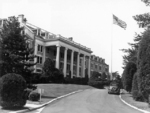Arlington Hall
| Type | 178 Government Building | |
| Historical Name of Location | Arlington, Virginia, United States | |
| Coordinates | 38.867600000, -77.103600000 |
Contributor: C. Peter Chen
ww2dbaseArlington Hall was founded in Arlington, Virginia, United States in 1927 as a private post-secondary women's educational institution. In 1940, it became a non-profit institution. In 1941, it operated under the name of Arlington Hall Junior College for Women, and its campus was about 100 acres in size. In Jun 1942, it was taken over by the United States Army under the provisions of the War Powers Act, and was turned over to the US Army Signals Intelligence Service. The cryptanalysts at Arlington Hall focused on breaking Japanese codes.
ww2dbaseArlington Hall remained in military and government use until the time of this writing, having been a facility for US Army, National Security Agency, Defense Intelligence Agency, State Department, and US Coast Guard.
ww2dbaseSource: Wikipedia
Last Major Update: Nov 2016
Arlington Hall Interactive Map
Photographs
 |  |
Arlington Hall Timeline
| 10 Jun 1942 | Under the War Powers Act the US Army took possession of Arlington Hall, a former girls' school, in Virginia, United States as its base for the Signals Intelligence Service. During the war Arlington Hall would concentrate its efforts mainly on decrypting Japanese codes. |
| 1 Jan 1977 | The United States Army Intelligence and Security Command was created with its headquarters at Arlington Hall, Arlington, Virginia, United States. |
Please consider supporting us on Patreon. Even $1 per month will go a long way! Thank you. Please help us spread the word: Stay updated with WW2DB: |
Visitor Submitted Comments
20 Dec 2017 10:55:12 AM
My grandfather Col Edward Lapping headed Special Branch at Arlington Hall during ww2. Does anyone know what Special Branch did?
All visitor submitted comments are opinions of those making the submissions and do not reflect views of WW2DB.

Arlington, Virginia, United States
Latitude-Longitude:
38.8676, -77.1036
- » 1,181 biographies
- » 337 events
- » 45,111 timeline entries
- » 1,246 ships
- » 350 aircraft models
- » 207 vehicle models
- » 376 weapon models
- » 123 historical documents
- » 261 facilities
- » 470 book reviews
- » 28,473 photos
- » 365 maps
Thomas Dodd, late 1945
Please consider supporting us on Patreon. Even $1 a month will go a long way. Thank you!
Or, please support us by purchasing some WW2DB merchandise at TeeSpring, Thank you!
2 Nov 2016 06:54:11 AM
On 19 January 1942, US Secretary of War, Henry Stimson, appointed as a special assistant, a Brooklyn-born lawyer named Alfred McCormack with a brief to examine the whole field of Sigint (Signals Intelligence gathering). Thereafter events moved swiftly. The Signals Intelligence Service moved from Washington’s Munitions Building to the former a former girls’ school in Virginia - Arlington Hall – ‘The Salt Mines’ – which soon occupied several dozen brick and wood-frame buildings in the grounds, and eventually employed 7,000 people, many of them civilians and women. ‘A’ section handled diplomatic and clandestine material. ‘B’ Section studied the Japanese Army; its card index eventually identifying 46,000 enemy officer. ‘C’ Section (‘Bunkers Hill’) addressed German material forwarded from Bletchley Park.
Despite repeated protests, the Hall was, until 1944, unable to obtain control over interception; responsibility for which was jealously guarded by the Army Signal Corps which maintained its own intercept arm and cryptographic school at Vint Hill Farms at Warrenton, Virginia. This was a serious handicap for the Army cryptanalyst who needed to create a network of interception stations from scratch until the last stages of the war. Nevertheless the achievements of Bletchley Park, Arlington Hall and the US Navy’s Op-20-G during the war would elevate intelligence gathering and codebreaking from a little-respected branch of staffwork, to unprecedented importance in operational planning.